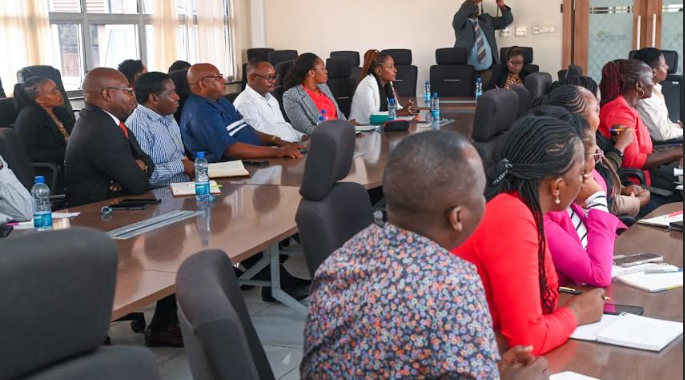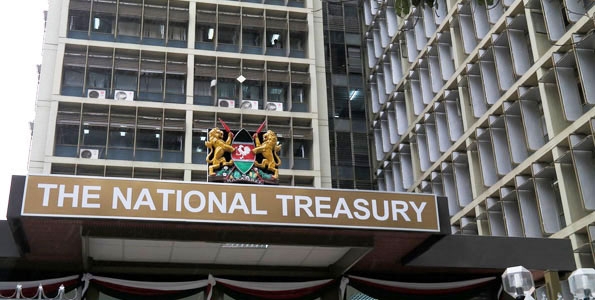
 Principal
Secretary of the State Department for Public Investments and Assets
Management, Mr Cyrell Odede Wagunda, addresses the heads of
procurement and Supply Chain Management in the Ministry of Health on
the status of eGP at the Kenyatta National Hospital./HANDOUT
Principal
Secretary of the State Department for Public Investments and Assets
Management, Mr Cyrell Odede Wagunda, addresses the heads of
procurement and Supply Chain Management in the Ministry of Health on
the status of eGP at the Kenyatta National Hospital./HANDOUTWhen Kenya began the transition from analogue to digital television broadcasting a decade ago, there was widespread resistance. However, the government’s firm stance ensured the process was completed, and today the results speak for themselves.
Since the digital switch, the TV broadcast industry has expanded rapidly, with 65 free-to-air stations—both public and private—now operating. Digital migration currently stands at an 80 per cent success rate.
This achievement appears to have inspired President William Ruto to push for the implementation of the Electronic Government Procurement (eGP) system despite ongoing criticism. He has highlighted the system’s benefits and remained steadfast in its rollout.
President Ruto likens the resistance to eGP to the opposition faced during the now-celebrated digital TV migration in 2015 and the growth of the Social Health Authority (SHA), attributing it to “old corruption fight back.”
In the busy hallways of the Kenyan governance, the e-GP has been regarded as a beacon of reform upon its launch back in April this year.
Having been mandated for full adoption by July 1, 2025, across all national and county entities, the platform promises to digitise everything from tender advertisements to payments with the aim of slashing corruption and inefficiency in the supply chain departments, which gulp over 60 per cent of the national budget.
Yet, as the system hits its five-month mark, a storm of criticism has erupted, wrongly painting a picture of a chaotic venture dogged by “exclusion and unfulfilled promises that could undermine the very economy it seeks to bolster.”
Critics argue that the e-GP rollout has been nothing short of a "disaster," as described by several governors, pointing to the hasty launch without proper testing that is bound to cause payments to freeze, stall operations and paralyse essential services in county schools, and hospitals, among other institutions, leaving them scrambling amid threats of legal challenges.
Even more damning, detractors claim that it fails to eradicate corruption and may foster new graft by creating loopholes for tech-savvy cartels, while billions vanish annually as the mandate is accused of being "illegal and unfair," bypassing equity principles in the Public Procurement and Asset Disposal Act 2015 and exposing self-dealing without root fixes.
“The economic fallout is stark, with delayed tenders and payments stalling projects, harming SMEs, and risking job losses and growth drags,” warns media reports.
However, these negativities have not gone unnoticed by the Government, which views the pushback as desperate late moves by vested interests clinging to the opaque manual of the old systems.
To President Ruto, the resistance is just a wild goose chase as it reminds Kenyans of the initial opposition against digital TV migration and the SHA roll out which sailed through under similar circumstances.
He has kept his feet down, warning public servants to "embrace the system or seek other employment venues," citing the e-GP as a non-negotiable system for curbing graft that has been siphoning funds from critical sectors of the economy.
"Procurement and accounting officers do not want this programme because they have been benefitting from the old system," Ruto declared, underscoring the government's resolve to integrate the platform with systems like IFMIS, iTax, and business registries for real-time tracking.
To fix the system from a rushed start, the Treasury, led by Cabinet Secretary John Mbadi, stepped up with more training and tech support.
As of August 2025, 7,637 suppliers had been registered and trained on the use of e-GP, with weekly webinars held every Thursday targeting broader adoption.
"We are not going to allow frustration with this system. You better embrace it and get going, as otherwise, we will save close to 200 billion if we implement it fully," Mbadi stated firmly.
Efforts include pulling budgets from IFMIS into e-GP, completing requisition integrations, and creating user accounts for heads of procurement, steps aimed at resolving teething problems like documentation lags without excusing resistance.
Addressing access issues, the government emphasises inclusivity features, such as integration with the Access to Government Procurement Opportunities (AGPO) for women, youth, and persons with disabilities, alongside indicative prices for common items to prevent overpricing.
Mbadi urges county governments to align and reject delays. "There's no justification; they all must be onboarded,” he cautions.
To tackle corruption concerns, the platform's digital trails provide verifiable evidence under the Conflict of Interest Act, automating processes to minimise human interference and enabling easier audits.
Early pilots have shown procurement cycles reduced by up to 50 per cent as per the Public Procurement Regulatory Authority (PPRA) report, with no reported fund losses and with discrepancies attributed to initial setup hurdles now resolved through advanced monitoring tools.
Progress metrics as of September 7, 2025, paint a picture of steady advancement amid the hurdles as of 638 targeted agencies, 547 (86 per cent) are compliant, including 62 state departments and 94 county assemblies fully onboarded.
Among county water companies, 81 out of 93 (87 per cent) are on board, and 33 counties have submitted budgets for upload.
The judiciary and parliament have trained over 420 staff, while exchequer releases are now tied to compliance to enforce participation.
Related wins, like cleaning up the Inua Jamii program to save over Sh600 million for indigent insurance, demonstrate the broader impact of such digital shifts.
 Heads of procurement and Supply Chain Management
in the Ministry of Health listen keenly to the Principal Secretary of the
State Department for Public Investments and Assets Management, Mr Cyrell Odede
Wagunda, as he updates them on the status of eGP at the Kenyatta National
Hospital/HANDOUT
Heads of procurement and Supply Chain Management
in the Ministry of Health listen keenly to the Principal Secretary of the
State Department for Public Investments and Assets Management, Mr Cyrell Odede
Wagunda, as he updates them on the status of eGP at the Kenyatta National
Hospital/HANDOUTPrincipal Secretary of the State Department for Public Investments and Assets Management, Cyrell Odede Wagunda, points out key milestones in the e-GP implementation, including the registration of 1,285 procuring entities and 7,637 suppliers, alongside the training of 100 Trainers of Trainees (TOTs).
“Training efforts have reached over 2,000 PFM officers from state departments and county governments, 180 state corporations, over 5,000 PFM officers from various Ministries, Departments, and Agencies (MDAs) through webinars, and over 4,000 suppliers via weekly sessions,” the PS says.
He emphasises that all procuring entities were now expected to forward budgets, create users, and initiate procurement planning with MDA budgets already uploaded, and counties were given until early this September for completion, and state corporations' uploads are ongoing.
Wagunda outlined the system's benefits, such as reduced costs for goods, works and services; increased transparency; improved efficiency by shortening procurement cycles; maximisation of value for money; enhanced accountability and confidentiality; integrity in transactions; streamlined processes through standardisation; and better procurement information management for planning, monitoring, evaluation and reporting.
Acknowledging teething problems, the PS affirmed no retreat from e-GP, urging continuous familiarisation and consultation with assigned TOTs for support as the focus now shifts from training to supporting respective Procurement Entities and other institutions of Government.
The National Treasury has mapped TOTs to all procuring entities and established a help desk at KISM Towers to ensure smooth transitions, insisting that all government business must occur electronically through the system.
The projected benefits are tantalising, including annual savings of Sh50–250 billion (up to 0.9 per cent of GDP, allowing redirecting of funds to infrastructure like roads, water projects and health facilities, far outpacing the current development budget of under Sh800 billion, bolstered by Sh250 billion from taxes.
"Every purchase will be traceable; citizens will know what was bought, at what cost, and from which supplier," President Ruto affirms, promising faster service delivery, fair competition for SMEs and a cultural shift toward accountability.
Impacts include better healthcare and education, timely supplies to hospitals and schools, more opportunities for youth and women-owned enterprises and greater citizen confidence in transparent spending.
As the country navigates this digital pivot under the Digital Superhighway Agenda, targeting 80 per cent of public services online, the e-GP stands as a testament to bold reforms.
Ashley Nadia works at the Office of Government Spokesperson















![[PHOTOS] Family, friends receive body of Raila’s sister, Beryl](/_next/image?url=https%3A%2F%2Fcdn.radioafrica.digital%2Fimage%2F2025%2F11%2Fdfe6a9bf-ede1-47a4-bdc0-4f564edb03dd.jpeg&w=3840&q=100)

